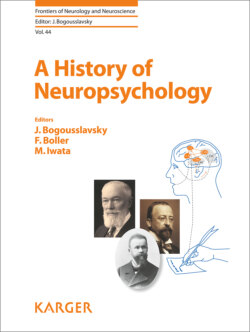Читать книгу A History of Neuropsychology - Группа авторов - Страница 75
На сайте Литреса книга снята с продажи.
1965: Rediscovery and New Directions
ОглавлениеThere were exceptions, such as Solomon Henschen (1877–1930) in Sweden and Johannes Nielsen (1890–1969) in Los Angeles, but the center–pathway model fell out of vogue during the early and middle decades of the 20th century. Ascendant views of Marie, Head, and Goldstein were reinforced by the works of Swiss pathologist Constantin von Monakow (1853–1930) on diaschisis (focal brain lesions exerted distant effects) and the American psychologist Karl Lashley (1890–1958) on equipotentiality (one part of the cortex could take over when another part was damaged).
In Boston, Geschwind revived earlier formulations of alexia and agraphia based on Dejerine’s center-pathway model. He was inspired by unexpected findings described by Roger Sperry (1913–1994) in split-brain patients, who had undergone corpus collosotomy, the surgical separation of the 2 cerebral hemispheres, to control intractable epilepsy [44]. With neuropsychologist Edith Kaplan (1924–2009), Geschwind reported a patient with agraphia of the left hand, which they interpreted as a functional disconnection of the 2 cerebral hemispheres [45]. Delving into the older neurological literature, Geschwind was “troubled by the fact that people who had left their mark so indelibly in many areas of neurology, such as Wernicke, Bastian, Dejerine, Charcot, and many others, could apparently have shown what was asserted to be the sheerest naiveté and incompetence in the area of higher functions” (p 215) [46]. In his landmark article of 1965, “Disconnexion syndromes in animal and man,” [2] Geschwind discussed Dejerine’s case of alexia without agraphia [35] and Liepmann and Maas’s case of unilateral agraphia [43]. These cases and others were adduced in support of a critical role for pathway lesions in disconnecting functionally discrete cortical regions [2]. Geschwind reinterpreted the left angular gyrus as a center for visual-auditory associations required for memories of the “‘rules of translation’ from written to spoken language” (p 279) [2]. For alexia without agraphia, the disconnection was between visual cortex and the left angular gyrus. For apraxic agraphia, the disconnection lay between right hemisphere motor cortex and left hemisphere language areas.
Geschwind’s disconnection theory – in conjunction with research of colleagues Harold Goodglass (1920–2002), Frank Benson (1928–1996) and others at the Boston University Aphasia Research Center – rekindled interests in what has become known as behavioral neurology [47] and led to new approaches to the study of aphasia, alexia, and agraphia, and of brain-behavior relations more generally. More than half a century after their rediscovery, the classic formulations of Dejerine and Liepmann retain their heuristic value.
